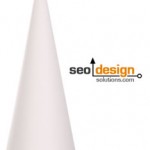Managing link equity for a website means creating preferential treatment for pages that have the highest potential for conversion. This becomes critical for on page SEO and managing ROI.
Depending on (1) your website monetization model (2) the type of consumer you need to facilitate and (3) the number of templates you have to work with, determines how pliable your SEO approach is when managing the flow of PageRank and link equity throughout a site.
The variables are:
- Primary navigation (number of links leaving/sapping a page)
- The number of words on a page
- The number of images and / or alt attributes image links
- The number of total vs. contextual links
- The number of link blocks (such as a footer, bulleted list, etc.)
Primary Navigation:
Unless you’re trying to create a duplicate content footprint that will haunt your less favorable pages by obscuring their focal point and chucking them into the supplemental index, then try to minimize noise in the primary navigation by creating a tiered navigation structure that consolidates the “most competitive” keyword verticals into the category structure.
Then from there, swap out that navigation or use a secondary navigation with text links (preferably as a link block or block quotes) cascading in the sidebar to push link equity into the deeper tier 3 product pages.
What is NOT ok, is to use the same navigation site wide for websites that need distinction and variance, and yes, while search engines will ignore the same elements (such as navigation) that they see over and over again to some extent, having granular control with the ability to toggle navigation schemas on or off is paramount as part of an optimal content management solution.
Ideally primary navigation links to the category page, then the category page serves as a carousel that links to the tier 3 pages. The tier 3 product pages (for example) would then link to the tier 2 /subfolder/ one away from the root and create a cycle for link flow to consolidate.
If you have multiple categories (topics) to feed then one thing we like to do is set up flat site architecture / landing pages, then push the link equity one subfolder away and then contextually link to the flat page for the primary landing / entry page, then link that primary landing page to select pages in the subfolder silo.
Number of words on a page:
While this metric is important for a number of reasons, we are talking about the way to create a preferred ROI platform. By scarcely adding a skeleton of content to a page, you allow other less prominent regions (such as the code in the template) or other common elements to suppress that page from capturing the spotlight for its own triage of keywords.
If you have 300 pages in your website, effectively you could optimize each for 3-5 keywords creating a blanket of 900 keywords delivering relevant traffic to the keywords contained in those pages. In other words, don’t waste the opportunity and do NOT leave it to chance.
Add enough content to provide a tipping point for the on page SEO, so when search engine spiders pass through they have enough information to assess and score that page. Sure, you can use off page ranking factors to augment the process, but SEO is about efficiency, so why waste link equity when all you need are a few links not a few hundred links to capture a prominent search engine position.
Using Images as Links:
Never underestimate the value of using images and alt attributes for SEO in tipping the balance of your on page optimization efforts.
If you do not want to add content and prefer to keep your pages lean (after you reach a perfect threshold), then using Alt attributes and images is an effective way to pass link equity while maintaining aesthetic appeal.
Contextual vs. Total Links:
If you are linking out more than 100 times on a page (use Xenu Link Slueth to investigate), then you really need to map out how many leaks you have leaving your pages. If you want to pass along ranking factor and genuine value for other pages within the site, then cap outbound links to a reasonable level and ensure that if you must link, that it uses relevant anchor text in the body area (to pass more value to subordinate or equally important pages).
Link Blocks:
If you must use blocks of links, keep them proportionate to the amount of content on the page. Search engines use a visual page segmentation algorithm (VIPS) model and can weight if there are disproportionate numbers of links to text, etc.
The trade-off of using contextual links or blocks of links to offset primary navigation must be weighed in accordance to their detrimental aspects (such as the side-effect of creating internal duplicate content) and should be used with discretion. Search engines can read and offering up “the same old new same” really isn’t that original.
Keep in mind, the page hierarchy in a website can make the difference between ranking and tanking your pages in search engines, so keep the metrics above in mind or use them as a method to audit your existing site structure to create optimal results for your search engine optimization efforts.







Good post Jeffrey. Just one thing I’m wondering about…
“Ideally primary navigation links to the category page, then the category page serves as a carousel that links to the tier 3 pages. The tier 3 product pages (for example) would then link to the tier 2 /subfolder/ one away from the root and create a cycle for link flow to consolidate.”
So it’s better to not have the primary (tier 2) navigation on every page, but rather have the tier 3 navigation of the page that a user is actually situated on?
So if I had as my navigation:
Apples
– green apples
– red apples
Grapes
…the homepage would link to the Apples and Grapes category pages as they’re tier 2, but if I was on the Apples category page there would only be navigation to the tier 3 pages of that category (green apples, red apples)? What would happen for the navigation at the tier 3 level?
Thanks again for your great posts, they really help.
Justin
Hi Justin:
With so many ways and applications, it really does depend on your objective.
This model of feeding the category / tier 2 page with primary navigation and then drilling down into the product level and creating a cyclical hook works well with deep links or sitemaps as the glue.
To answer your question, tier 3 links back to tier 2 category (which could just be a bread crumb to emphasize and consolidate the tier 2 as the champion page).
Two reasons, (1) it has more chances of ranking for multiple keywords if (a) it is being fed from primary navigation(2) from the standpoint of usability when a visitor arrived, they could click right into the more specific page.
If you want the tier 3 pages to rank they already have a great sponsor for anchor text (from tier 2) as a relevant themed link (if their absolute).
The final ingredient is a few powerhouse deep links to give them enough citation from peer review to pass enough juice to become buoyant in the SERPs.
Make sense?
I see, thank you Jeffrey. I just wasn’t sure whether taking away primary links from every page would limit their internal linking and as such be detrimental to their ranking.
Your reply actually jogged my memory on one more thing that I was reading about a couple of days ago. I create a lot of my sites in Drupal and by default navigation links are relative rather than absolute. As I thought absolute links are more SEO friendly I altered my setup for all links to become absolute on my site. Is it still the case that absolute links are better for SEO than relative or doesn’t it make much difference?
Thanks again for the great posts and replies you provide.
Hey Justin:
Although absolute links tax the server a bit more, they are well worth the weight as your own web pages can transfer an authoritative vote on behalf of another page (just like an off site referrer).
Jeffrey
Ok cool, thanks for that Jeffrey.
Justin
This is a really great tips. I read and learn some good knowledge about of onpage seo. thanks for sharing..